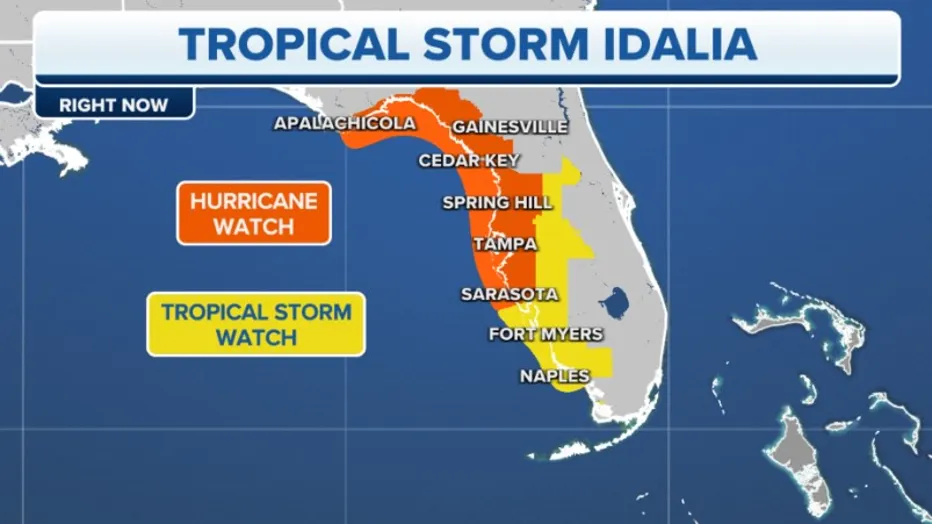Hurricane Ian vs Idalia Path: Hurricanes are among the most destructive natural disasters that can affect coastal and inland areas. They are powerful storms that form over warm ocean waters and produce strong winds, heavy rain, storm surge, flooding, and tornadoes. In 2023, two major hurricanes, Ian and Idalia, made landfall in the United States within a month of each other, causing widespread damage and disruption across several states.
In this article, we will compare and contrast the paths, impacts, and lessons learned from these two hurricanes.

Hurricane Ian vs Idalia Path
Table of Contents
Hurricane Ian was the ninth named storm, fourth hurricane, and second major hurricane of the 2023 Atlantic hurricane season. It originated from a tropical wave that moved off the coast of Western Africa and across the central tropical Atlantic towards the Windward Islands. The wave moved into the Caribbean Sea on September 21 bringing heavy rain and gusty winds to Trinidad and Tobago, the ABC islands, and the northern coast of South America. On the morning of September 23, the wave had enough organization to be designated as a tropical depression, after which it strengthened into Tropical Storm Ian early the next day while it was southeast of Jamaica. As Ian rapidly intensified into a Category 3 hurricane, it made landfall in western Cuba. Heavy rainfall caused widespread flooding across the area resulting in a nationwide power outage.
Ian lost a minimal amount of strength while over land and soon re-strengthened while over the southeastern Gulf of Mexico. It peaked as a Category 5 hurricane with sustained winds of 160 mph (260 km/h) early on September 28, while progressing towards the west coast of Florida, and made landfall just below peak intensity in Southwest Florida on Cayo Costa Island. In doing so, Ian tied with several other storms to become the fifth-strongest hurricane on record to make landfall in the contiguous U.S. After moving inland, Ian quickly weakened to a tropical storm before moving back offshore into the Atlantic. There it re-strengthened to become a hurricane once again before making its final landfall in South Carolina on September 30. Ian became extratropical shortly after landfall and fully dissipated by early the next day.
Hurricane Idalia was the tenth named storm, third hurricane, and second major hurricane of the 2023 Atlantic hurricane season. It formed from a low-pressure area that crossed Central America from the eastern Pacific Ocean. Gradual development ensued as it meandered in the western part of the Caribbean Sea; the system was upgraded to a tropical depression on August 26, 2023, and strengthened into a tropical storm a day later, receiving the name Idalia. It traversed the Gulf of Mexico where it underwent rapid intensification, briefly becoming a Category 4 hurricane prior to making landfall in the Big Bend region of Florida at Category 3 strength on August 30.
Idalia remained a hurricane as it moved through Northern Florida and crossed into Southeast Georgia; it then pushed into the Carolinas as a tropical storm. On August 31, Idalia emerged into the Atlantic, where it transitioned into a post-tropical cyclone that same day. Later, it passed south of Bermuda, made a counterclockwise loop, then meandered off the coast of Nova Scotia while winding down. Idalia was the most powerful hurricane to hit Florida’s Big Bend region since the 1896 Cedar Keys hurricane.
Impacts
Hurricane Ian caused 161 fatalities: 5 in Cuba, 150 in Florida,5 in North Carolina, and 1 in Virginia. It also caused widespread damage across western Cuba, Florida, and the Carolinas. Ian was estimated to have caused $113 billion (2023 USD) in damage, making it the third-costliest weather disaster on record and the costliest in Floridan history. The storm surge from Ian reached up to 20 feet (6 m) in some areas along the Florida coast, inundating homes and businesses. The wind damage from Ian was also severe, with numerous buildings destroyed or damaged by flying debris or falling trees. The rainfall from Ian caused flash flooding and river flooding in many locations, especially in North Carolina where some rivers reached record levels. The storm also spawned several tornadoes that caused additional damage and casualties.
Hurricane Idalia caused 7 direct fatalities and 3 indirect fatalities: 4 in Florida, , , , , , , , , , 2 in Georgia, , and 1 in South Carolina. It also caused significant damage to thousands of homes, businesses, and other infrastructure along its inland path, primarily in Florida, where winds and the resulting floodwaters were highest. Its storm surge was record-breaking from the Big Bend region south to Tampa Bay. The system also spawned a tornado outbreak with around 12 confirmed tornadoes. Early estimates placed insured losses at $2.2–5 billion. The hurricane’s remnants produced dangerous rip currents across the Eastern United States during Labor Day Weekend, resulting in several additional deaths and numerous rescues.
Lessons Learned
Hurricanes Ian and Idalia highlighted the need for better preparedness and resilience in the face of such powerful and destructive storms. Some of the lessons learned from these hurricanes include:
- The importance of evacuating when ordered to do so by authorities. Many people who stayed behind in the evacuation zones faced life-threatening conditions and had difficulty accessing rescue services or emergency supplies. Evacuation orders are issued based on the best available information and are intended to protect lives and property.
- The need for adequate insurance coverage and disaster assistance. Many people who suffered losses from the hurricanes did not have sufficient insurance coverage or were unaware of the available resources to help them recover. Insurance policies should be reviewed regularly and updated to reflect current values and risks. Disaster assistance programs should be well-publicized and easily accessible to those who qualify.
- The value of having a personal or family emergency plan and kit. Having a plan and a kit can help people cope with the disruptions and challenges caused by a hurricane. A plan should include information on how to communicate, where to go, what to do, and what to bring in case of an emergency. A kit should contain essential items such as water, food, medications, flashlight, radio, batteries, cash, documents, and personal hygiene items.
- The benefit of strengthening homes and communities against hurricane hazards. There are many ways to reduce the vulnerability of homes and communities to hurricane hazards such as wind, water, and debris. Some examples are installing storm shutters or impact-resistant windows, elevating structures above flood levels, clearing vegetation and debris from roofs and gutters, securing outdoor items or bringing them indoors, reinforcing doors and garage doors, and creating or joining a community emergency response team.
Hurricanes Ian and Idalia were two of the most devastating hurricanes to hit the United States in recent years. They showed the immense power and unpredictability of nature and the vulnerability of human society to its impacts. They also taught valuable lessons on how to prepare for, respond to, and recover from such disasters. By learning from these experiences, we can hope to reduce the risks and enhance the resilience of ourselves and our communities in the face of future hurricanes.
Stay tuned to CHOPNEWS for the latest scoops and updates of Business News, Sports News, Technology News, World News and Entertainment News.













































